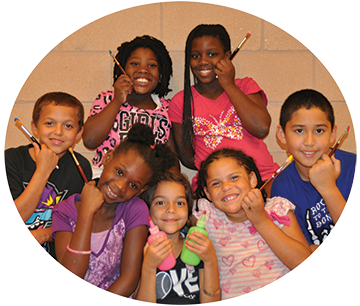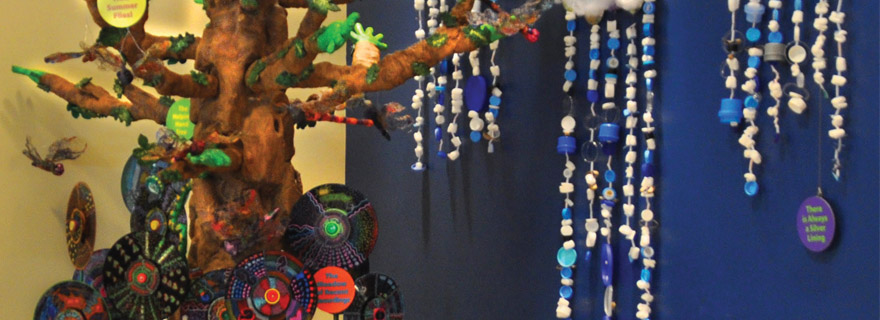CAlling all youth to get creative about climate change messages
By Sigrid Tidmore
In some ways, young people appreciate living in Tampa Bay even more than their parents. Just go to the beach. Who looks like they’re having the most fun?
Children of all ages thrive in our fragile environmental playground, but its very existence depends upon our success in the face of climate change. Most scientists agree that climate change is real and that it will affect Tampa Bay within our children’s lifetime.

Giving youth a public forum
Community Stepping Stones (CSS), a nonprofit that brings “Art+Science” programming to hundreds of at-risk youth, wondered what children would say if they could speak up about the Tampa Bay they will grow up to inherit.
“Children are the most disenfranchised group in the conversation about climate change,” said CSS Education Director Brenda Gregory. “And yet they are the ones who are the most vulnerable to its impacts, now and in the future.”
With funding from a Tampa Bay Estuary Program mini-grant, CSS produced an educational workshop for adults who find themselves instructing children on science and art. “It’s not always easy for an instructor to lead a constructive conversation about climate change,” said Gregory.
“We don’t want to scare children with doomsday facts or get caught in political overtones. Kids want to express concerns about complex issues but they are clearly at a language disadvantage. However, they can communicate amazingly well through their art.”
Thus was born the idea for “THINK eARTh: The Tampa Bay I Want to Inherit,” an educational program that gives kids a chance to speak up about climate change through art.
The process works like this:
• Science training is offered to adults who want to instruct youth on how climate change is impacting Tampa Bay. Our program offers teaching materials, resource assistance and project ideas.
• Trained instructors guide youth to learn about climate change in an age-appropriate way.
• By using art projects to connect scientific knowledge with creative expression, instructors are encouraged to help students interpret what they learn so they can express their feelings about it.
• Coordinated by Community Stepping Stones, instructors collaborate to produce public art exhibitions that provide a venue for the children’s ideas in high-traffic areas.
Teaching the teachers:
On a Saturday in early February, 30 people got together for the first THINK eARTh gathering. Science and art instructors from Hillsborough County Public Schools, as well as instructors from private schools and after-school programs, met with four earth science experts to hear the latest climate change information. Marten Schönfeld, a USF humanities professor who observed how populations deal with denial in the face of imminent danger, kicked off the program. His message was both profound and simple:
YES! — Climate change is real and it’s happening
YES! — The impact will be felt within our children’s lifetimes
YES! — We can still do something about it, but not if we wait
YES! — We must de-politicize science and take affirmative action now
Sea level rise and transitions in critical coastal habitat already are occurring, Ed Sherwood, senior scientist with the Tampa Bay Estuary Program, told the group. By the end of this century, we could see a three- to six-foot rise in bay water, with major losses of seagrass, salt marsh and tidal flats. These changes will create significant drops in Tampa Bay’s most popular sport fish: flounder, redfish, sheepshead, snook, spotted sea trout and tarpon.
David Karlen, representing the Environmental Protection Commission of Hillsborough County, shared his concerns about increasing water temperatures, changes in weather patterns and ocean acidification. These trends can result in changes in species distribution (invasive species arrive while native species disappear), hypoxia (a drop in dissolved water oxygen), more frequent harmful algae blooms, and decreased populations of shellfish and crustaceans due to the decalcification of their protective shells and skeletons.
Finally, Tyson Facto, the lead aquarist from Lowry Park Zoo, discussed the collapse of food webs as the diversity of plants and animals diminished due to the loss of food sources. It was then that Schönfeld made his most prescient point: “Ultimately, climate change will all come down to FOOD. In an unchecked world, food will begin to disappear for every species.”
You can see the slide presentations of the experts and hear excepts from their talks at http://communitysteppingstones.org/students/think-earth-student-project/
Science = Art: Kids can make a creative contribution
The first THINK eARTh Youth Art Exhibition will debut at Hillsborough Community College/Ybor City, beginning July 5. At least three other locations are planned for later dates, including Children’s Board of Hillsborough County and public buildings, museums, libraries and schools in a variety of bay area locations.
“We’re seeking passionate partners – school instructors, home-school parents, after-school teachers – adults who have great ideas for these exhibitions and want to inspire their children to create interpretive art,” adds Gregory. “This is an on-going program that gives youth a voice in the most important issue of our time. “
For more information, access to teaching resources, coaching and a program application, email climate@communitysteppingstones.org or call 813-932-1950.
What kids can do to slow climate change
 Participate in the THINK eARTh youth art exhibition project.
Participate in the THINK eARTh youth art exhibition project.- At Home: epa.gov/climatechange/wycd/home AT SCHOOL: epa.gov/climatechange/wycd/school
- For Tampa Bay:
- Reduce your energy use.
- Walk, bike or carpool when possible.
- Eat wisely.
- Choose foods that are local, seasonal, organic and low on the food chain whenever possible.
- Learn to grow some of your own food.
- Take care of your trash. Compost organic waste and reuse or recycle other items instead of discarding items to help reduce the greenhouse gas emissions associated with landfills.
- Minimize use of synthetic fertilizers and pesticides which are made and distributed using fossil fuels.
- In General: Stay informed, get involved in community action.
